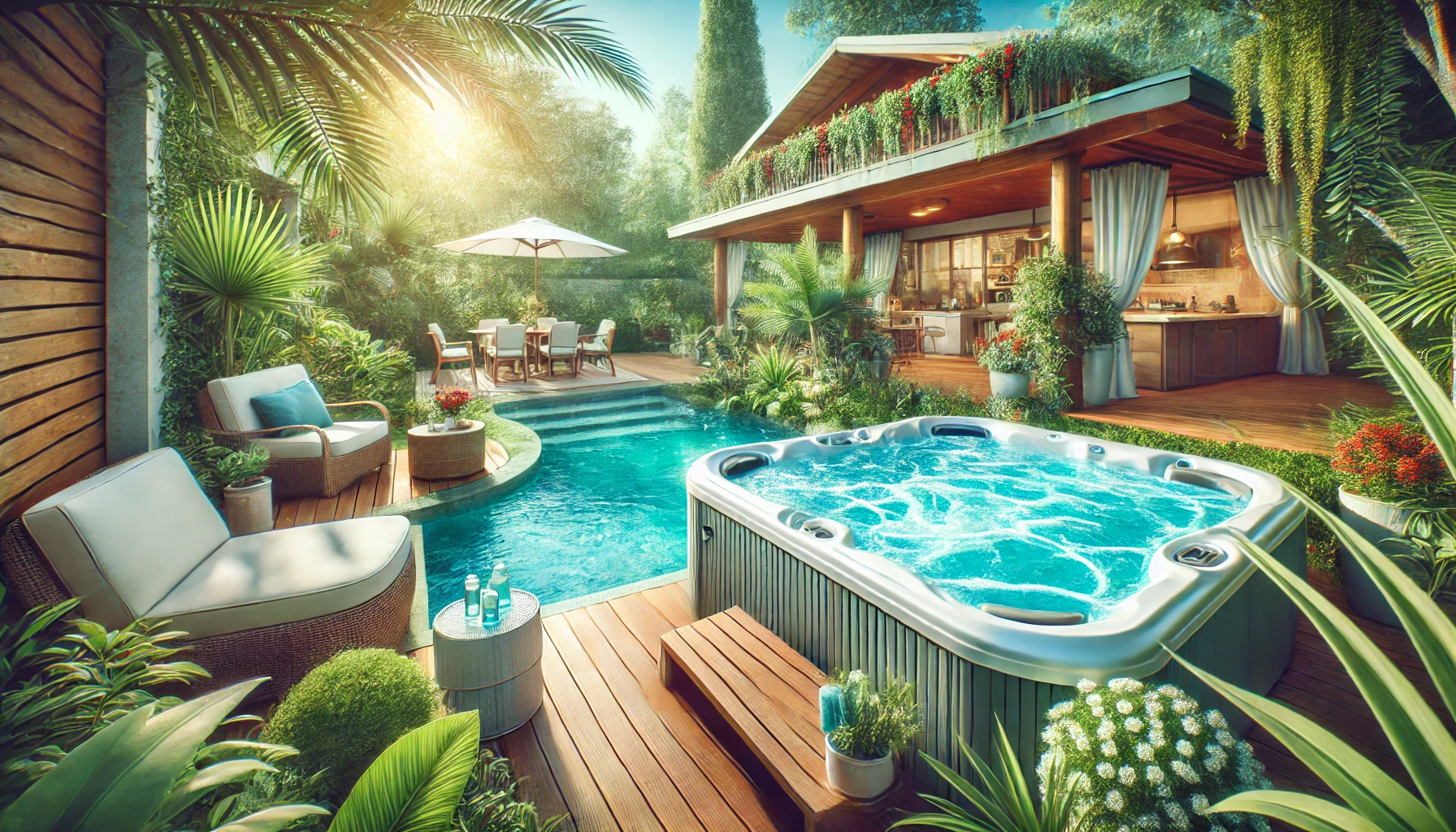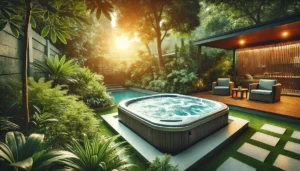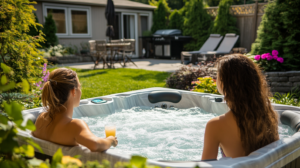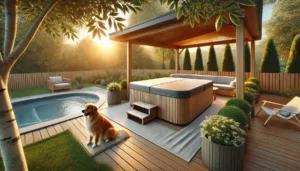Hey there, fellow hot tub enthusiasts! Ever found yourself in a situation where your hot tub water just doesn’t feel quite right? Maybe it’s a little cloudy, or there’s that funky smell that makes you wrinkle your nose.
Well, chances are you’re dealing with a low free chlorine situation. Don’t worry, I’ve been there more times than I’d like to admit during my 15 years of hot tub ownership.
Today, I’m gonna spill the beans on how to get those chlorine levels up and keep your hot tub as fresh as a daisy.
How to Raise Free Chlorine in Your Hot Tub
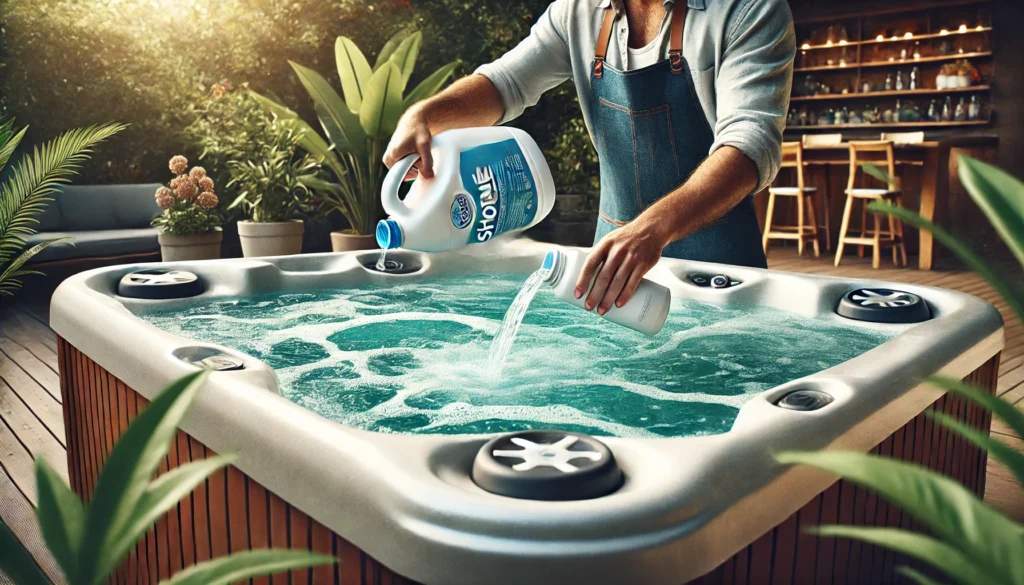
As a hot tub owner for over 15 years, I’ve learned that raising free chlorine levels is crucial for maintaining a clean and safe soaking environment. To increase free chlorine in your hot tub, start by testing the current levels using a reliable test kit.
Then, add chlorine shock or granular chlorine to the water, following the manufacturer’s instructions for dosage. Run the jets for at least 30 minutes to distribute the chlorine evenly.
Retest after a few hours and repeat the process if necessary. Remember, maintaining proper pH levels (between 7.2 and 7.8) is essential for chlorine effectiveness.
We’ll explore this topic more deeply below, including common mistakes to avoid and alternative methods for raising free chlorine.
Understanding Free Chlorine in Hot Tubs

Alright, let’s get down to the nitty-gritty. Free chlorine is like the superhero of your hot tub.
It’s the active form of chlorine that’s ready to fight off all those nasty bacteria and contaminants that try to crash your relaxation party. Trust me, you want this guy on your side!
Now, here’s the deal: you wanna keep your free chlorine levels between 3-5 parts per million (ppm). Any lower, and you’re basically inviting germs to have a field day in your tub.
Been there, done that, and let me tell you, it ain’t pretty!
But here’s the kicker – free chlorine levels can be as fickle as my old cat, Whiskers. One day they’re perfect, the next they’ve dropped faster than my enthusiasm for New Year’s resolutions.
Things like sunlight, heat, and how many people use your tub can all mess with your chlorine levels. Heck, I once had a party where we all jumped in the hot tub, and the next day, my chlorine levels were lower than my bank account after a shopping spree!
Testing Chlorine Levels

Listen up, ’cause this is important: testing your chlorine levels regularly is like checking the oil in your car. You gotta do it if you want things to run smoothly.
I learned this the hard way when I skipped testing for a couple weeks and ended up with a tub full of algae. Talk about embarrassing!
There are a bunch of test kits out there, but I swear by the good ol’ test strips. They’re quick, easy, and you don’t need a PhD in chemistry to use ’em.
Just dip, wait, and compare colors. Easy peasy!
But here’s a pro tip: don’t be like me and leave your test strips on the patio table. Turns out, they don’t like sunlight any more than vampires do.
I once used some sun-bleached strips and thought my chlorine levels were perfect. Spoiler alert: they weren’t.
Always store your test kit in a cool, dry place, okay?
Methods to Raise Free Chlorine
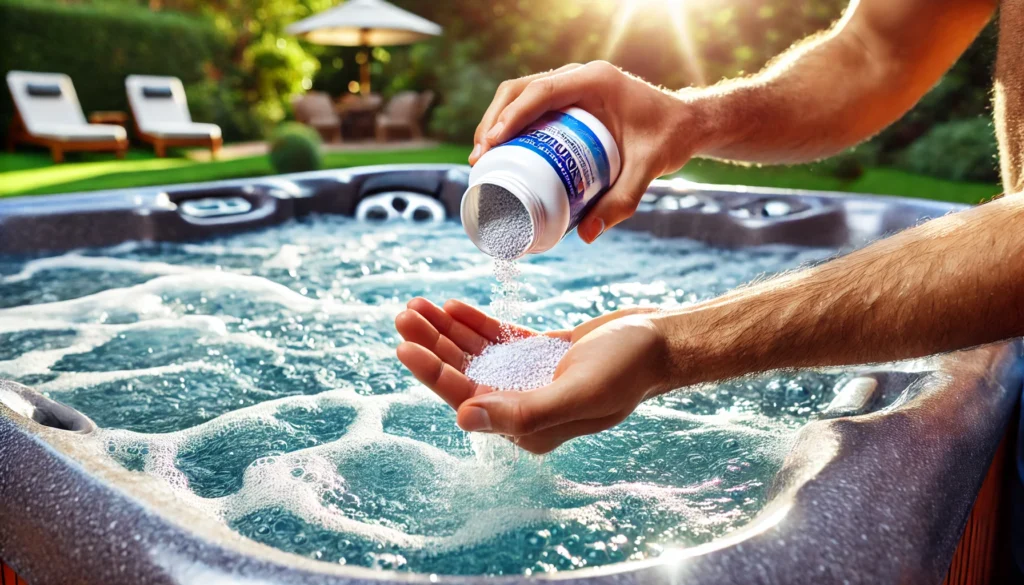
Alright, so your test shows low free chlorine. Don’t panic! We’ve got options, my friend.
Here’s what you can do:
Chlorine shock is like giving your hot tub a strong cup of coffee. It’ll wake those chlorine levels right up!
Just make sure you follow the instructions on the package. I once got a little too enthusiastic and turned my tub into a chlorine soup.
My skin wasn’t happy about that!
Granular chlorine is my go-to method. It’s easy to measure and dissolves quickly.
Just sprinkle it around the tub while the jets are running. But watch out for those white shorts – I learned the hard way that chlorine and fashion don’t always mix!
Liquid chlorine works too, but be careful when pouring. I once spilled some on my favorite t-shirt, and now it looks like a tie-dye experiment gone wrong.
Salt chlorine generators are pretty nifty if you’re tired of manually adding chlorine. They convert salt into chlorine for you.
It’s like having a little chlorine factory right in your tub!
Whichever method you choose, always run your jets for at least 30 minutes after adding chlorine. This helps distribute it evenly.
I once forgot to do this and ended up with one half of the tub super chlorinated and the other half… well, let’s just say it was a breeding ground for things I’d rather not think about!
Factors Affecting Chlorine Effectiveness
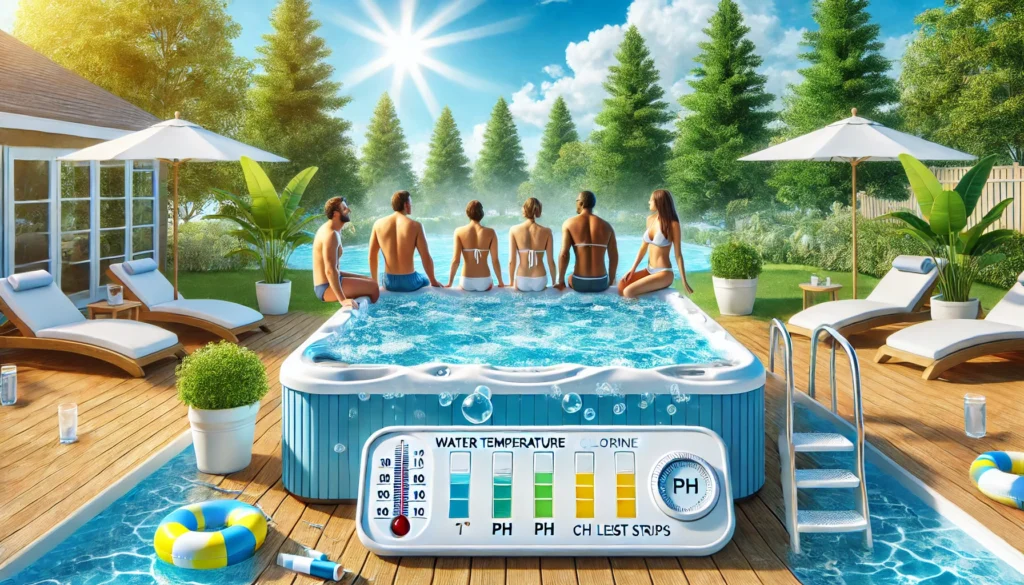
Now, here’s where things get a bit tricky. You can’t just dump chlorine in your tub and call it a day.
There are a few other factors you gotta keep an eye on:
pH levels are crucial, folks. If your pH is off, your chlorine might as well be on vacation.
You want it between 7.2 and 7.8. I once let my pH get too high, and no matter how much chlorine I added, it just wouldn’t work.
It was like trying to clean my house with a feather duster – lots of effort, no results!
Temperature plays a role too. Hot tubs are, well, hot.
And heat makes chlorine work faster, which means it gets used up quicker. During a heatwave last summer, I had to check and adjust my chlorine levels almost daily.
It was like playing whack-a-mole with water chemistry!
Bather load is a fancy way of saying “how many people use your tub.” The more people, the more stuff gets into the water (sweat, oils, etc.), and the harder your chlorine has to work.
After hosting a big family reunion, I swear my hot tub looked at me and said, “I quit!” It took a week to get the chemistry back in balance after that shindig!
Common Mistakes to Avoid

Alright, gather ’round for story time. I’m gonna share some mistakes I’ve made so you don’t have to:
Overusing chlorine is a big no-no. More is not always better, trust me.
I once thought if a little chlorine is good, a lot must be great. Wrong!
My tub turned into a bleach bath, and my skin was not happy.
Neglecting other water balance factors is another pitfall. Don’t be like me and focus solely on chlorine.
I ignored my alkalinity levels for months and ended up with water so unstable, it was like trying to relax in a bottle of soda.
Inconsistent maintenance can really mess things up. Procrastination is the enemy of a clean hot tub.
I once got lazy and skipped maintenance for a few weeks. Let’s just say the resulting cleanup took way more time and effort than if I’d just stuck to my routine.
Remember, balance is key. Treat your hot tub like a delicate ecosystem, not a chemistry experiment gone wild!
Alternative Sanitizers and Complementary Methods

Now, I know some of you might be thinking, “Isn’t there an easier way?” Well, you’re in luck! There are some alternatives and complementary methods you can use:
Bromine is chlorine’s cousin. Some folks prefer it because it’s gentler on the skin.
I tried it once, and it worked great, but the smell reminded me of my high school swimming pool, so I switched back.
UV systems use ultraviolet light to zap bacteria. It’s like having a little sun inside your hot tub!
I installed one last year, and it’s been a game-changer. I still use chlorine, but not nearly as much.
Ozone generators produce ozone gas that helps sanitize the water. It sounds sci-fi, but it works!
A buddy of mine swears by his ozone system.
Mineral purifiers use minerals like silver and copper to keep your water clean. I haven’t tried this myself, but I’ve heard good things.
Might be worth looking into if you’re sensitive to chlorine.
Remember, these methods usually work best when combined with a bit of chlorine. It’s like having a backup singer – they’re great on their own, but even better together!
Maintaining Proper Chlorine Levels
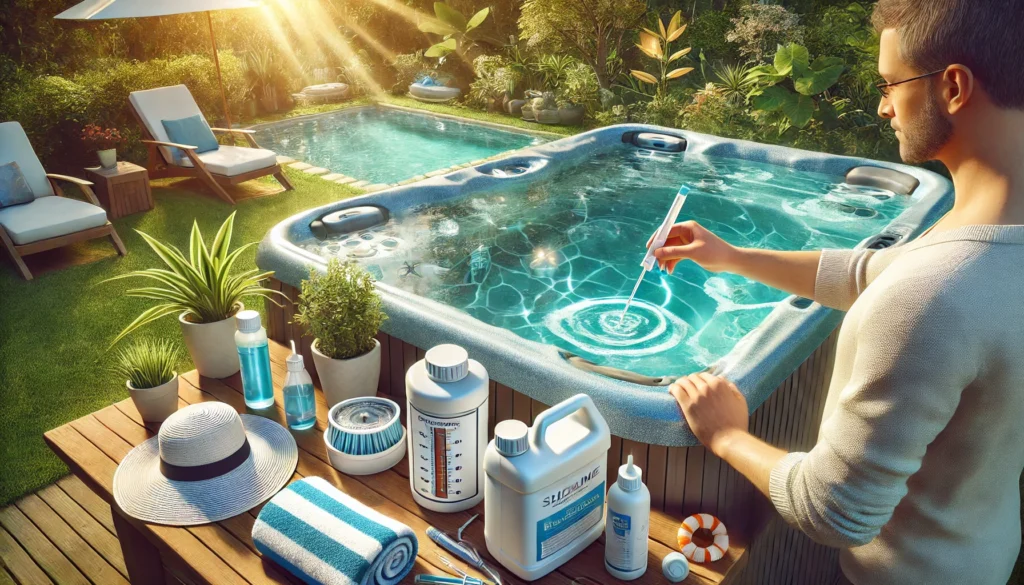
Alright, here’s the secret sauce to keeping your hot tub happy: consistency. Yeah, I know, it’s not exciting, but trust me, it works.
Here’s what I do:
Test the water at least twice a week. I do it every Monday and Thursday, right after my morning coffee.
It’s become such a habit that I feel weird if I don’t do it!
Add chlorine as needed based on your test results. Don’t wait for it to drop to zero before adding more.
That’s like waiting for your car to run out of gas before filling up!
Shock your tub once a week, even if the chlorine levels look okay. It’s like giving your tub a mini spa day.
Clean your filters regularly. Dirty filters make your chlorine work overtime.
I learned this the hard way when I couldn’t figure out why my chlorine levels kept dropping. Turns out, my filters were so clogged they could’ve passed for a science experiment!
Adjust your routine with the seasons. In summer, you might need to test and add chlorine more often.
In winter, you might be able to get away with less frequent maintenance.
Remember, a little effort goes a long way. It’s way easier to maintain a balanced tub than to fix a neglected one!
Safety Considerations
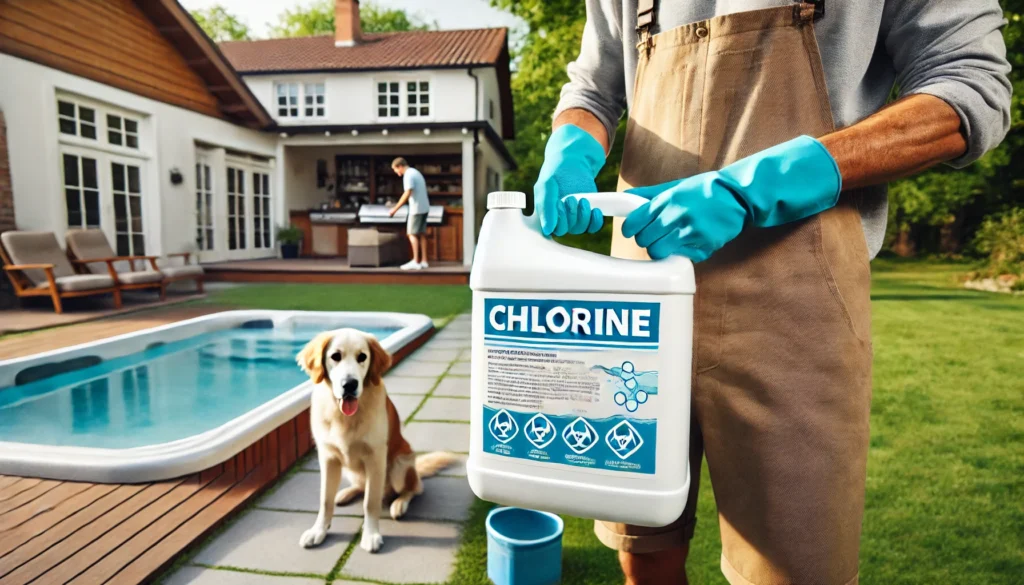
Okay, let’s get serious for a moment. Chlorine is great for keeping your hot tub clean, but it can be dangerous if not handled properly.
Here are some safety tips I’ve learned (sometimes the hard way):
Always store chlorine in a cool, dry place away from other chemicals. I once stored my chlorine next to some other cleaning supplies in my shed.
Let’s just say the resulting smell made me regret skipping chemistry class in high school!
When adding chlorine, make sure the area is well-ventilated. I learned this lesson when I tried to shock my indoor hot tub without opening the windows.
My eyes were watering for hours!
Never mix different types of chlorine or chlorine with other chemicals. This isn’t the time to channel your inner mad scientist.
Wait at least 30 minutes after adding chlorine before getting in the tub. I know it’s tempting to jump right in, but trust me, your skin will thank you for waiting.
Keep chlorine out of reach of kids and pets. My dog once got into a bucket of chlorine tablets.
Thankfully, he didn’t eat any, but the vet bill for the check-up was no joke!
Remember, a safe hot tub is a fun hot tub. Don’t let your relaxation time turn into a hazard!
Conclusion
Whew! We’ve covered a lot of ground, haven’t we? From understanding free chlorine to avoiding common mistakes, you’re now armed with all the knowledge you need to keep your hot tub sparkling clean and safe.
Remember, maintaining proper chlorine levels isn’t just about having clean water – it’s about creating a safe and enjoyable environment for you, your family, and your friends to relax and unwind. It might seem like a lot of work at first, but trust me, once you get into a routine, it becomes second nature.
I’ve had my fair share of hot tub mishaps over the years, from green water to skin irritations, but each mistake taught me something new. Now, I can confidently say that my hot tub is my own personal oasis, always ready for a relaxing soak at the end of a long day.
So, don’t be discouraged if you don’t get it right the first time. Hot tub maintenance is a journey, not a destination.
Keep at it, learn from your mistakes, and before you know it, you’ll be the go-to hot tub guru in your neighborhood!
Now, I want to hear from you! What’s your biggest challenge when it comes to maintaining your hot tub?
Any tips or tricks you’ve discovered along the way? Share your experiences in the comments below.
After all, we’re all in this bubbly boat together!
Remember, every hot tub is a bit different, so don’t be afraid to experiment (safely!) to find what works best for your setup. Maybe you’ll discover a maintenance schedule that fits perfectly with your lifestyle, or perhaps you’ll find the perfect combination of sanitizers that keeps your water crystal clear with minimal effort.
Oh, and one last thing – don’t forget to actually enjoy your hot tub! It’s easy to get so caught up in the maintenance that we forget why we got these wonderful water havens in the first place.
So go ahead, schedule that soak, invite some friends over, or just enjoy a quiet evening under the stars. You’ve earned it!
Here’s to clear water, relaxing soaks, and the satisfaction of a well-maintained hot tub. Happy tubbing, everyone!
P.S. If you found this guide helpful, why not share it with your fellow hot tub owners? Let’s spread the knowledge and keep all our hot tubs happy and healthy!
